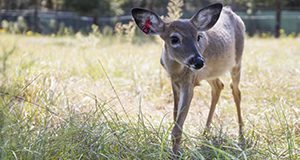Abstract
The white-tailed deer (Odocoileus virginianus) is the most economically important big game mammal in North America and Florida. This 12-page fact sheet written by Raoul K. Boughton, Bethany Wight, Samantha Wisely, Karen Hood, and Martin B. Main and published by the UF/IFAS Department of Wildlife Ecology and Conservation provides an overview of the various subspecies of white-tailed deer with populations in Florida and describes their history, biology, and management.
https://edis.ifas.ufl.edu/uw121
References
Bellis, E. D., and H. B. Graves. 1971. “Collision of vehicles with deer studied on Pennsylvania interstate road section.” Highway Res. News 42:13–17.
Brown, R. D. (ed.). 1983. Antler development in the Cervidae. Caesar Kleberg Wildlife Institute, Kingsville, TX.
Crawford, D. A., M. J. Cherry, B. D. Kelly, E. P. Garrison, D. B. Shindle, L. M. Conner, R. B. Chandler, and K. V. Miller. 2019. "Chronology of reproductive investment determines predation risk aversion in a felid‐ungulate system." Ecology and Evolution 9:3264-3275. https://doi.org/10.1002/ece3.4947
Curtis, P. S., and M. E. Richmond. 1992. “Future challenges of suburban white-tailed deer management.” Trans. N. Amer. Wildl. & Nat. Res. Conf. 57:104–114.
Gerlach, D., S. Atwater, and J. Schnell (eds.). 1994. Deer. Stackpole Books, Mechanicsburg, PA. 384 pp.
Goss, R. J. 1983. Deer antlers: regeneration, function, and evolution. Academic Press, New York. https://doi.org/10.1016/B978-0-12-293080-5.50012-9
Halls, L. K. 1984. White-tailed deer: ecology and management. Stackpole Books, Harrisburg, PA.
Harlow, R. F. 1959. “An evaluation of white-tailed deer habitat in Florida.” Tech. Bull. 5, Fl. Game & Fresh Water Fish Comm., Tallahassee, FL. 69 pp.
Harlow, R. F. 1961. “Fall and winter foods of Florida white-tailed deer.” Q. J. Fl. Acad. Sci. 24:19–38.
Harlow, R. F. 1972. “Reproductive rates of white-tailed deer in Florida.” Q. J. Fl. Acad. Sci . 35:165–170.
Harlow, R. F., and F. K. Jones (eds.). 1965. “The white-tailed deer in Florida.” Tech. Bull. 9, Fl. Game & Fresh Water Fish Comm., Tallahassee, FL. 240 pp.
Henderson, F. R., and C. Lee. 1992. “Controlling deer damage.” Coop. Ext. Serv. Fact Sheet C-728, Kansas State Univ., Manhattan, KS. 8 pp.
Hygnstrom, S. E., and S. R. Craven. 1988. “Electric fences and commercial repellents for reducing deer damage in corn fields.” Wildl. Soc. Bull. 16:291–296.
Kammermeyer, K., and R. Thackston. 2019. “Deer & Turkey Management: Beyond Food Plots.” Kent Kammermeyer Consulting, LLC. http://www.deerconsulting.com/beyondfoodplots.aspx
Logan, T. H., and A. Egbert. 1981. The Florida deer story. Fl. Wildl. (Nov.–Dec.).
Richter, A. R., and R. F. Labisky. 1985. "Reproductive dynamics among disjunct white-tailed deer herds." Fl. J. Wildl. Manage. 49:964-971. https://doi.org/10.2307/3801380
Severinghaus, C. W., and E. L. Cheatum. 1969. The life and times of the white-tailed deer. Pp. 57–186 In: W.P. Taylor, (ed.). The Deer of North America. Harrisburg, PA: Stackpole Book.
Smith, T. R., C. G. Hunter, J. F. Eisenberg, and M. E. Sunquist. 1996. "Ecology of white-tailed deer in eastern Everglades National Park—An overview." Fl. Mus. Nat. Hist. 39:141–172.
VerCauteren, Kurt C., and Michael J. Pipas. 2003. A Review of Color Vision in White-Tailed Deer. Wildlife Society Bulletin, vol. 31, no. 3, 2003
Unless otherwise specified, articles published in the EDIS journal after January 1, 2024 are licensed under a Creative Commons Attribution-NonCommercial-NoDerivs 4.0 International (CC BY-NC-ND 4.0) license.

